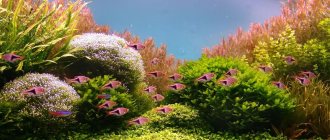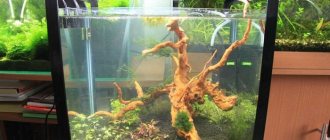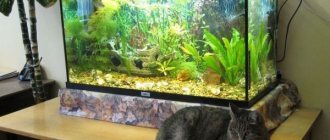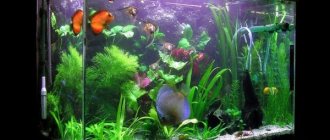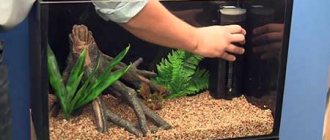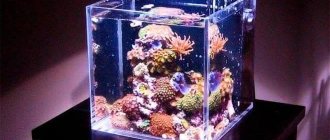A 10 liter aquarium is a very small aquarium; Currently, aquariums up to 30 liters are called nana. Often, beginner aquarists buy a container for fish of such a small volume. They naively believe that the smaller the aquarium, the better - it’s easier to care for and takes up less space. This is partly true, but due to the fact that the water volume is too small, the owner of such an aquarium will face several problems:
- It is difficult to maintain biological balance in such a small volume;
- Water temperature strongly depends on the environment and changes frequently, which is extremely undesirable for fish, shrimp and plants.
- It is difficult to avoid overpopulation.
How to avoid problems, what equipment is needed, whether soil is needed and how much, what fish to choose, as well as plants and decorations, regular care.
Advantages and disadvantages
Aquarium tanks have a number of pros and cons, which will be useful for those who decide to purchase a similar design. Let's start with the positive aspects.
- 10 liter containers are a great starting point. It's no secret that maintaining and servicing large tanks requires experience and skills, and troubles that happen to them affect your financial condition. In a small aquarium, everything is much easier to fix.
- Ten-liter containers are very compact, they will be an ideal option for small apartments, in addition, they are convenient for spawning of some types of fish.
- Such aquariums can be moved from place to place, which is convenient for beginner aquarists who are just learning from their mistakes. This trick will not work with a 100 liter capacity.
- It is much easier to care for a small aquarium than for a spacious container with different fish.
However, this solution also has disadvantages.
- Size, which many consider a plus, for some will be a negative side of the issue. After all, such aquariums cannot accommodate many fish, and not all varieties are suitable for keeping. Plant placement can also be a problem.
- If the aquarium is round, then cleaning it will cause a lot of inconvenience. The filter in such containers becomes dirty faster than in large tanks, and therefore frequent water changes lead to stress for the inhabitants of such a home.
- The last drawback also applies specifically to round containers. This shape distorts the sun's rays, and it may seem to the fish that something is moving on the walls. It scares them and makes them nervous.
What kind of fish to get and how to feed them correctly
What kind of fish to get in a small artificial reservoir and how to feed them correctly is the next question.
First of all, you need to pay attention to the size of the fish. Their size should not exceed 20-30mm. Fish for a small vessel should be not voracious, with calm and non-aggressive behavior, and also small in size. It is also recommended to select representatives with bright colors. These could be Guppies, Barbs, Cockerels, Danios, Neon.
In addition, dwarf frogs can often be seen in small artificial reservoirs. All of them are shown in the photo below. An artificial pond with one goldfish looks great. But in general, decor, selection of fish, decorative living plants is a very labor-intensive and delicate work. If you properly care for the aquarium and fish, then even in a small vessel the fish will grow. It becomes very crowded for them and they require sitting down.
If we talk about keeping the Cockerel fish in a small aquarium, then we must take into account the fact that this fish is very pugnacious. It would be better to keep it separately, since such a pet will be very aggressive towards any neighborhood. The males are very beautiful and varied. They have luxurious fan-shaped fins. Their photos can be seen below. Life expectancy ranges from 1 to 3 years. With proper care it reaches up to 7 centimeters. Feels great at a temperature of 22-30 degrees. When changing the water and cleaning the aquarium, the betta is caught with a net and transplanted into another container.
You cannot pick up the fish with your hands. You need to feed this fish with dry food. Since the betta is a labyrinth fish, it does not need equipment to supply light. If there is only a male in the aquarium - Cockerel, this is okay. The cockerel does not have to breed. The aquarium must be covered with a lid to prevent this fish from jumping out.
Neons are also very well known to everyone. They can be seen in the photo below. They live in flocks. It is best to purchase them in quantities of at least 5 individuals. They are unpretentious and thrive in not very harsh water environments.
Danio rerio fish is popular among beginners. They are very nimble and cheerful. Stay in flocks.
Well, the whole aquarium hobby begins with a fish named Guppy. They are not at all whimsical, beautiful, and also very prolific. They will immediately give birth to live fry, without laying eggs.
All these fish need to be fed little by little and not often. It is necessary to ensure that the fish is well-fed, but not overfed. Aquarium fish must eat all the food. It is best to feed your fish with commercial food.
Having familiarized yourself with all the descriptions and recommendations, and having made the right decision for yourself, maintaining a small artificial reservoir will not cause any inconvenience.
https://youtube.com/watch?v=GSx4cfrSmqo
Kinds
10 liter aquariums can be of many different types. Let us list the main models of such containers.
- Round. These are common, classic products in which a goldfish is immediately imagined. They are made of silicate glass, the standard size is 29 cm in diameter, most often 24 cm in height.
- Rectangular. Most often, modern nanoaquariums equipped with many interesting functions are produced in this form. The dimensions of such aquariums are 20x20x25 cm, sometimes deviations may occur. Also, rectangular models are equipped with a lid.
- Square . Such products are just as convenient and popular as rectangular ones; they can easily be placed on a closet shelf or office desk. They look very stylish, the parameters are mainly 20.5x21.5x23 cm.
In addition, the description of the varieties will be incomplete if the materials from which the aquariums are made are not indicated.
- All glass. These are very beautiful, but incredibly fragile products that need to be looked after very carefully. All-glass tanks must stand on a perfectly level place, since on a curved area they will move or even fall, which will cause the death of underwater inhabitants.
- Frame. These are already stronger structures, however, not without certain disadvantages. The frame is made of metal, which means it can rust when interacting with water. To avoid poisoning your pets, buy aquariums with a stainless steel frame, and also use special cleaning products.
- Acrylic. Acrylic, which is organic glass, allows you to create beautiful-looking tanks. The only downside is that the glass may become cloudy and scratches may appear on it. But this can only happen after several years of regular use.
Aquariums, sizes
Aquariums up to 10 liters in size can be found in round, rectangular and cubic shapes. Here are just a few of the most common ones
Aquarium set Nature, mini cube 9.5 liters
Size (width/depth/height) : 22cm x 22cm x 22cm
The kit includes:
- Aquarium
- Lamp LED-105
- Internal filter FC-603
- Surface glass
- Mat for aquarium (izolon)
Aquarium set Fluval “Spec” 10 liters
Size (width/depth/height) : 25cm x 31cm x 31cm
The kit includes:
- Aquarium
- Internal filter
- LED lamp
- Plastic cover
- Water treatment products
Aquael “Shrimp Set Smart” aquarium set 10 liters
Size (width/depth/height) : 20cm x 20cm x 25cm
The kit includes:
- High transparency glass aquarium
- Cover glass
- LED lamp
- Filter
- Heater
Aquarium set Tetra “Silhouette” 12 liters
Size (width/depth/height) : 33cm x 35cm x 29cm
The kit includes:
- Aquarium
- Stand with LED lighting
- Filter
- power unit
AquaNano aquarium set 10 liters
Size (width/depth/height) : 20cm x 20cm x 25cm
The kit includes:
- Aquarium
- Scenery
- Lamp
- Filter
- Priming
Aquarium AquaNano Ball 10 liters
Size (width/height) : 28cm x 24cm
How to choose?
Every person buys an aquarium for a specific purpose. Typically, there are two goals here:
- a tank that is convenient specifically for fish, the shape and features do not matter;
- a container designed to decorate the interior and highlight the taste of the owner.
In the first case, you need to immediately pay attention to the material of manufacture. Of course, it is best to purchase acrylic structures, since silicate glass breaks easily. In addition, the thickness of the glass walls should not be too small, especially in models with silicate glass.
That is why experts advise choosing an aquarium in stores where you can look at it and touch it. Ordering online is quite risky. It is also worth noting such a moment as the lid. This item is very important for rectangular and square aquariums. If the cover is not included, you must purchase it yourself.
If you are buying an aquarium more as a decorative item, and the varieties of fish are in second place, then here the shape, on the contrary, will be very important. Round aquariums are perfect for both classic and modern designs. In the latter, they will smooth out the sharp corners of the room and give it comfort. Shapes such as square or rectangle are chosen exclusively for modern interiors.
In addition to choosing the aquarium itself, think about purchasing various accessories, as well as purchasing beautiful soil and exquisite plants. You can additionally purchase colored lighting.
Important: when buying an aquarium, be sure to ask the seller for all instructions and certificates, accompanying documents and warranty cards.
Recommendations
Choose an aquarium with the largest volume of water you can find room for. Any home aquarium that cannot be fitted with a filter or heater must be handled with great care. For example, it is difficult to install any equipment in a small round aquarium. And such a container will need special care. In a separate article you can read “How to care for a small round aquarium.”
It is better to find a small but fully functional aquarium. There are many of these on sale, small in size, and with all the necessary equipment: lighting, filter, heater and primer. You can even find micro aquariums from 7 liters in volume with a full set of everything you need.
Where to install?
Due to the size of a small aquarium, there are many places in your apartment or house where you can put it. Let's look at some useful tips.
- The surface on which the tank will stand must be strong enough to support the weight of 10 liters. This could be, for example, a table or a stable shelf.
- Since the temperature in such a small tank is more difficult to control, you need to choose an area that will be located away from heating devices and drafts. If this is not done, temperature changes will begin that are unacceptable for fish.
- The aquarium cannot be placed in direct sunlight or in places where it is too noisy. All this will cause stress and illness in pets.
- The reservoir must be freely accessible. It should be easy for you to approach him for feeding and grooming. In addition, professional aquarists recommend placing the container at eye level, this causes psychological comfort. However, if you have agile pets or children in the house, the aquarium should be located where they cannot reach it.
Caring for a small aquarium correctly
If all the necessary conditions are created, you will always be able to admire the beauty of your fish. As for water filtration, the built-in filter is not quite enough to provide the desired balance.
In a small filter, beneficial bacteria do not multiply quickly. Therefore, such a filter will often become dirty and will need to be washed more often. In the material that is filtered, beneficial microorganisms are formed that process ammonia, and the fish will be saved from poisoning. This means that it is strictly forbidden to overpopulate an artificial reservoir with inhabitants.
You also need to make sure that your pets eat all the food. But even if it remains, then it must be removed immediately. This means that overfeeding fish is also unacceptable.
The temperature of the water in the vessel greatly affects the health of the fish. In small artificial reservoirs, water can cool and heat up very quickly. Then you need to install the aquarium in a place where the temperature will practically not change, or purchase a heater that will maintain the temperature at the desired level.
As for changing the water, you need to change the water in a small aquarium twice as often as in a large one. Pre-treatment of water is necessary before changing it. It needs to be settled and filtered to remove chlorine. Also, this water should have the same temperature and hardness as in the aquarium. And most importantly, it must be saturated with oxygen.
In a small aquarium it is necessary to have live plants. They have a charitable influence on the fish. It is very convenient to grow various plants in small artificial reservoirs, since they have much more lighting. Of the plants, these can be simple and unpretentious, such as pinnates and hornworts. You can also use Brazilian lileopsis and marsilia. They are shown in the photo below. If there are artificial figures in the aquarium, they also need to be cleaned when changing the water.
Lighting
There are different versions of lighting in aquariums, and of course. Fish should not be left completely without lighting. Fish need light just like they need oxygen. But a small ten-liter aquarium will heat up too much from the constant presence of a lamp on the inside of the aquarium lid, so in this case only external lighting will work for you - a small pendant lamp with a fluorescent lamp will be quite enough. When wondering whether you need to keep the lights on all the time, you can safely answer yourself “no.” If in nature fish observe the change in time of day, noticing dark and illuminated water, then ornamental fish require light in the same way.
You can equip the aquarium with a lamp with a timer so that the light turns on and off automatically every twelve hours: this will be quite enough for the fish and will not create any problems for the owner of the animal, because you won’t have to worry whether you turned the light on or not for the fish.
What kind of fish is suitable for a mini aquarium?
What fish can be kept in mini aquariums? Pets with miniature body sizes should be placed in a small 10-20 liter tank. Fish 2-6 centimeters in length will tolerate this volume of water. But remember that even small fish want to swim in a spacious environment. They should not be kept in containers that will restrict movement. Territorial and aggressive fish should not be placed in mini aquariums. Which ones should not be placed in 10-liter aquariums? These are swordtails, medium-sized barbs, cichlids, gourami, and zebrafish. They have an active and energetic disposition and require more hiding space.
In an aquarium of 10-20 liters you can put small barbs, Gertrude pseudomugil, rice fish, cherry barbs, rasbor, erythrozonus, neons, Amanda tetra. You can also keep the following fish and shrimp there: otocinclus catfish, corydoras, amano shrimp, cherry shrimp, copper tetra. Representatives of the genus Poeciliaceae, viviparous fish, get along well in mini tanks.
You need to buy fish breeds with strong immunity, that is, not purebred fish, but hybrids. If you do not have the opportunity to buy a spacious “house” for your small pet, you need to buy a small aquarium with a capacity of 10 liters. The well-known Siamese cockerels are also often housed there. The cockerel can live alone and does not get along with its relatives; it is a fighting fish, after all.
Other inhabitants
For a small 10-liter aquarium, in addition to fish, other inhabitants are also suitable. In this volume, 8-10 medium-sized shrimp, for example, neocaridine or crystals, will feel comfortable. They come in different colors and are quite unpretentious. You can also keep shellfish in a nano-aquarium. Snails such as apple snails, neretina and helena are characterized by their attractive appearance. Some aquarists keep Hymenochirus frogs in miniature tanks. These amphibians do not require access to land, and they are unpretentious to environmental conditions. However, it should be remembered that if the container is not covered with a lid, its occupants may escape.
Decoration and design
When designing an aquarium designed for 10 liters of liquid, you should avoid using too large decorative elements, and also adhere to minimalism in the process of creating an aquarium design.
Beautiful stones or driftwood will help create a beautiful decor that is close to the natural environment and will not take up much space. Some types of fish need shelters and secluded corners. In such cases, it is permissible to use decorative elements such as ceramic houses or castles. The main thing is to pay attention to their size and not to overload the tank with decorations, so as not to deprive the aquarium inhabitants of free space to move.
It is recommended to avoid using artificial plants and massive decorations that attract increased attention.
Green spaces
Green spaces must be present in an artificial reservoir, especially for miniature nano-aquariums. Aquatic and surface cultures not only decorate an artificial pond, but also help maintain optimal biological balance, which is extremely important for small aquarium volumes.
Important! As with decorative elements, it is important to use moderation and not overdo it. Experts advise aquarists to plant small-sized plant crops in small aquariums, characterized by slow growth rates.
Selection of plants. The ideal choice would be:
- Aquatic moss and cladophora - creeping along the bottom of an artificial reservoir.
- All types of ferns and anubias - these plant crops grow slowly and do not require intensive lighting and nutritious soil.
- Ground cover crops (hemianthus, riccia, vertical heteroclita, etc.) are ideal for growing in a miniature aquarium, but require nutritious soil. Therefore, additional oxygen supply and periodic application of mineral fertilizers will be required.
Near the back walls of the aquarium, you can plant blueberry, Cryptocoryne parva, staurogyne, Echinodorus quadricostatus, since these green spaces reach no more than 15 cm in height.
How many fish can you stock?
The most important rule for any aquarist is to avoid overcrowding an artificial reservoir.
Counting rules. The optimal volume of water should be calculated after filling the aquarium with soil, plants and decorative elements. As a rule, about 8-9 liters of liquid remain. It is based on this volume that you need to calculate the number of ornamental fish suitable for living in the tank.
On average, 1 individual should have at least 1.5 liters of water.
Thus, in a 10 liter aquarium it is permissible to keep no more than 5-6 fish. In this case, it is necessary to take into account the size that an adult reaches - both in length and width.
Priming
Soil is important when setting up any aquarium, especially if we are talking about a small artificial pond. The fact is that the soil, in addition to being decorative, also performs a filtering function, promoting the proliferation of beneficial bacteria and the formation of optimal microflora.
Size.
For a 10 liter aquarium, fine soil ranging from 1 mm to 4 mm is ideal.
When using a larger fraction, the likelihood of food particles getting into it increases, leading to the development of putrefactive processes.
Kinds. An excellent choice would be such types of soil as sand, crushed pebbles, basalt, crushed granite.
Coating. The soil should cover the bottom of the artificial reservoir by 1-3 cm. For a 10 liter aquarium you will need from 600 g to 2 kg of soil.
What pets are prohibited from being kept in nano-aquariums?
First of all, you need to find out which types of fish are absolutely not suitable for keeping in an artificial reservoir with a volume of 10 liters. Such aquariums are not used for raising aggressive, predatory, territorial fish. Naturally, large, massive fish are excluded from the list of potential inhabitants.
It is acceptable, but not advisable, to keep small but active and mobile fish, since due to insufficient free space to move, they will feel unwell and may even become seriously ill.
Strictly not suitable for keeping in an aquarium with a volume of 10 liters of liquid:
- medium barbs;
- cichlids;
- goldfish;
- zebrafish;
- swordtails;
- gourami.
Keeping large varieties of ornamental shrimp is also not allowed.
Experts strongly recommend populating such a small nano-aquarium with representatives of the same species.
Thus, it will be easier to calculate the permissible number of inhabitants of an artificial reservoir and create comfortable conditions for them.
Basic equipment
Most freshwater aquariums require very basic equipment: a filter, a compressor, and a heater.
Each of these devices deserves a separate discussion, since their correct selection and installation play a big role in the comfort and well-being of the inhabitants of the aquarium.
Filter
Most filters are divided into two categories - internal and external. This separation depends on the method of attaching the filter to the aquarium. Some filters can be attached externally, to the wall of the aquarium, but in ordinary home aquariums, internal ones are usually used, which are attached directly to the wall inside the aquarium underwater.
The most common are small compact models that work on the simplest principle: under water pressure they pass streams through themselves, trapping dirt and turbidity from the water inside. Some filters have a special impregnation inside, which allows you to change the chemical composition of water for the better. When installing a filter in a ten-liter aquarium, you run the risk of encountering certain difficulties: the filters are quite large and can create too much water flow and take up a lot of space in the jar. In this case, you need to choose small filters with low power so that filtration does not turn into constant distillation of a small volume of water. This will not be beneficial either for the water or for its inhabitants, who will only be irritated by constant fluctuations. So, we have selected a filter and install it in the aquarium. We carefully attach it to one of the side walls so as not to block the main view of the inhabitants. You definitely need to make sure that the filter does not reach the bottom a little, and since the water is constantly evaporating, you need to check this regularly. The end of the tube that supplies air to the filter should go out. We check how stable the filter is and connect it to the mains. There are several important points related to enabling or disabling the filter:
- Do not leave the filter turned off in the aquarium for more than a couple of hours: when air circulation is disrupted, the filter begins to release harmful substances back into the water.
- Personal safety precautions: do not put your hands in the water for any reason while the filter is in the water. While catching one of the pets or regulating some elements, you can turn off the filter for a short time, but it is important that it be turned on immediately after all manipulations.
- If the filter has been turned off for a long time, you cannot turn it on immediately, for the same reason as leaving it turned off for a long time. Before starting up after a long period of inactivity, the filter must be cleaned or the filter material in it must be replaced.
- Be sure to make sure that the filter is completely immersed in water: working in the open air, the filter breaks faster.
Due to the small volumes, it is difficult to select a filter for a ten-liter aquarium. Nevertheless, there are small options, since such an aquarium already needs active and constant filtration. But in any case, the filter in the aquarium will be constantly visible to both an external observer and the fish themselves, since the small space does not allow it to be hidden or disguised. Therefore, if you lower the filter, then, preferably, not for long at all, and then immediately turn it off and put it away.
Compressor
Some fish do not need an additional source of oxygen. However, even if there are plants that release oxygen into the water, you can equip a ten-liter aquarium with a compressor that will enrich the water with oxygen. Of course, there is no need to keep the compressor on all the time, but it is recommended to turn it on once or twice a day for an hour so that the supply of oxygen in the water is always sufficient and the fish feel good.
The compressor itself is not mounted inside the aquarium, but is usually placed on the lid or back wall, and only a hose with a sprayer through which is immersed inside the aquarium. Actually, oxygen is transferred.
Many people do not turn on compressors at night, as this is the noisiest piece of equipment. But, nevertheless, these days this element is already produced and is completely silent, so medium-power compressors with a short hose can be left just overnight and you can sleep almost next to the aquarium.
Lighting
There are different versions of lighting in aquariums, and of course. Fish should not be left completely without lighting. Fish need light just like they need oxygen. But a small ten-liter aquarium will heat up too much from the constant presence of a lamp on the inside of the aquarium lid, so in this case only external lighting will work for you - a small pendant lamp with a fluorescent lamp will be quite enough. When wondering whether you need to keep the lights on all the time, you can safely answer yourself “no.” If in nature fish observe the change in time of day, noticing dark and illuminated water, then ornamental fish require light in the same way.
You can equip the aquarium with a lamp with a timer so that the light turns on and off automatically every twelve hours: this will be quite enough for the fish and will not create any problems for the owner of the animal, because you won’t have to worry whether you turned the light on or not for the fish.
Heater
In a small aquarium, if it is constantly located in an apartment, in principle, a heater is not really needed. Since the temperature in such an aquarium needs to be kept quite low, it is of course worth attaching a small thermometer in a visible place to monitor temperature fluctuations. But due to its small size, it is very difficult to choose a heater: either the water will overheat or cool down if such a heater is turned off for a long time for fear of overheating. But in winter, when it’s cold in the house, the water will cool down in any case, and the fish will get sick and even die. Therefore, no matter how difficult it may be, it is still necessary to choose the right heater. A small heater with the ability to regulate maintaining a certain temperature is suitable, but you need to approach the choice very responsibly. Fortunately, there are several options for small heaters that will do their job very well.
Compressor
Some fish do not need an additional source of oxygen. However, even if there are plants that release oxygen into the water, you can equip a ten-liter aquarium with a compressor that will enrich the water with oxygen. Of course, there is no need to keep the compressor on all the time, but it is recommended to turn it on once or twice a day for an hour so that the supply of oxygen in the water is always sufficient and the fish feel good.
The compressor itself is not mounted inside the aquarium, but is usually placed on the lid or back wall, and only a hose with a sprayer through which is immersed inside the aquarium. Actually, oxygen is transferred.
Many people do not turn on compressors at night, as this is the noisiest piece of equipment. But, nevertheless, these days this element is already produced and is completely silent, so medium-power compressors with a short hose can be left just overnight and you can sleep almost next to the aquarium.
